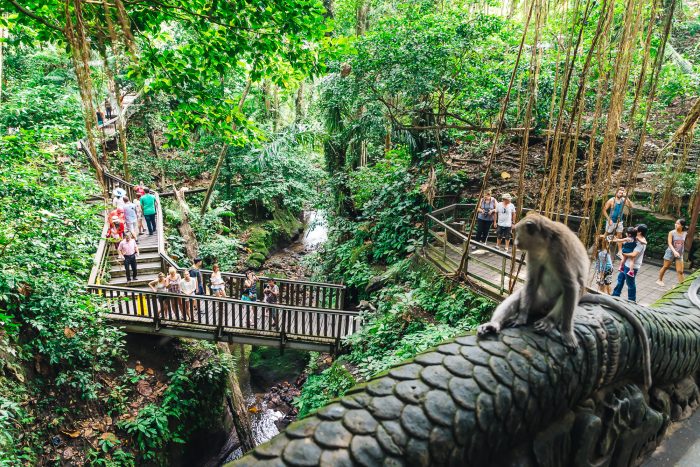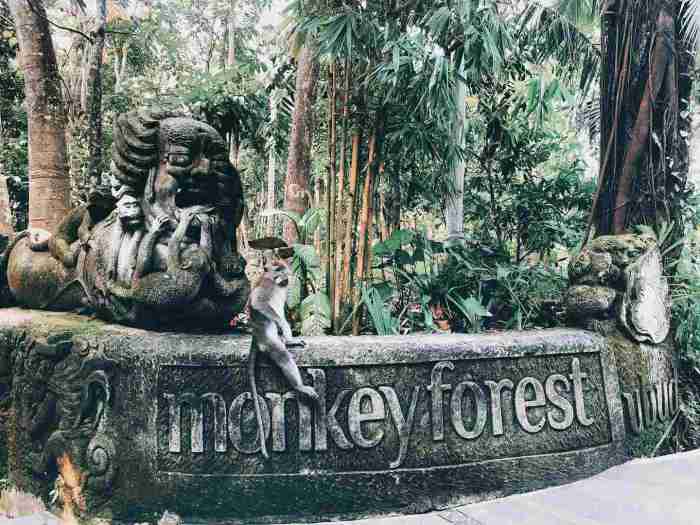Nestled amidst the lush rainforests of Ubud, Bali, the Sacred Monkey Forest Sanctuary is a captivating haven where nature, culture, and spirituality intertwine. As you step into this enchanting realm, prepare to encounter playful macaques, explore ancient temples, and immerse yourself in the rich traditions of the Balinese people.
Established in 1939, the sanctuary has evolved into a vital center for the conservation of the Balinese long-tailed macaque and a sanctuary for a diverse array of flora and fauna. With its stunning landscapes, sacred temples, and unique cultural practices, the Sacred Monkey Forest Sanctuary offers a profound experience that will leave an indelible mark on your memory.
History of the Sacred Monkey Forest Sanctuary
Nestled amidst the lush greenery of Ubud, Bali, the Sacred Monkey Forest Sanctuary holds a profound cultural and religious significance for the local community. Its establishment dates back to the 14th century, when a Hindu priest named Mpu Kuturan founded the nearby Pura Dalem Agung Padangtegal temple.
As the temple gained prominence, the surrounding forest became a sacred sanctuary for the long-tailed macaques that inhabited the area. The monkeys were considered sacred beings, believed to be the descendants of Hanuman, the Hindu monkey god. Over time, the sanctuary became a place of pilgrimage and worship for both locals and visitors alike.
Founders and Purpose
The Sacred Monkey Forest Sanctuary was formally established in 1935 by the Dutch colonial administration. Its primary purpose was to protect the monkeys and their habitat while also promoting cultural tourism. The sanctuary was placed under the management of the local community, who have been responsible for its preservation and development ever since.
Cultural and Religious Significance
For the local Balinese community, the Sacred Monkey Forest Sanctuary holds immense cultural and religious importance. The monkeys are revered as sacred beings, and the sanctuary is considered a sacred place where they can be observed and worshipped. Many locals believe that the monkeys possess magical powers and can bring good luck or protection.
The sanctuary also serves as a living example of the Balinese concept of Tri Hita Karana, which emphasizes the harmonious relationship between humans, the environment, and the divine. By protecting the monkeys and their habitat, the community is honoring their religious beliefs and maintaining a balance with nature.
Geography and Biodiversity
The Sacred Monkey Forest Sanctuary is situated in Ubud, Bali, Indonesia, nestled within a lush rainforest ecosystem. The sanctuary spans 12.5 hectares, providing a habitat for a diverse array of flora and fauna.
Ecosystem
The sanctuary’s unique ecosystem is characterized by its tropical rainforest vegetation, which creates a microclimate that supports a wide range of plant and animal life. The towering trees provide shade and shelter, while the dense undergrowth offers food and nesting sites for various species.
Amidst the lush greenery of the Sacred Monkey Forest Sanctuary, where playful macaques roam freely, lies a hidden gem: the Saraswati Temple. This serene sanctuary dedicated to the Hindu goddess of knowledge and music provides a tranquil retreat within the bustling sanctuary.
Its intricate carvings and calming atmosphere offer a glimpse into Balinese culture and spirituality, making it a must-visit destination for those exploring the Sacred Monkey Forest Sanctuary.
Flora
The sanctuary boasts a rich diversity of plant life, including over 100 species of trees, shrubs, and herbs. Among the notable flora are the majestic banyan trees (Ficus benghalensis), known for their intricate root systems, and the strangler fig (Ficus aurea), which envelops host trees with its aerial roots.
Sacred Monkey Forest Sanctuary is a must-visit destination in Bali. To get there, you can take a train to Cikini Station , which is located in the heart of Jakarta. From the station, you can take a taxi or bus to the sanctuary.
The sanctuary is home to over 700 monkeys, and it’s a great place to learn about their behavior and habitat.
Fauna, Sacred monkey forest sanctuary
The sanctuary is renowned for its population of Balinese long-tailed macaques (Macaca fascicularis), which are the main attraction for visitors. These highly social primates are known for their playful and mischievous behavior. Other notable fauna include the Javanese long-tailed macaque (Macaca fascicularis), the common palm civet (Paradoxurus hermaphroditus), and a variety of bird species.
Conservation
The Sacred Monkey Forest Sanctuary is actively involved in conservation efforts to protect its biodiversity. These efforts include monitoring and managing the macaque population, reforestation initiatives, and educational programs to raise awareness about the importance of the sanctuary’s ecosystem.
Macaque Population and Behavior: Sacred Monkey Forest Sanctuary

The Sacred Monkey Forest Sanctuary is home to a diverse population of macaques, primarily long-tailed macaques (Macaca fascicularis). The resident macaque population is estimated to be around 600 individuals, distributed across several social groups.These macaques exhibit a complex social structure, with each group led by a dominant male.
The social hierarchy is maintained through a combination of grooming, aggression, and appeasement behaviors. Macaques are omnivorous, feeding on a variety of fruits, leaves, insects, and small animals. They are known for their opportunistic feeding habits, often raiding nearby farms and gardens.
Unique Behaviors
Macaques in the sanctuary exhibit a range of unique behaviors, including:
Tail Flicking
Amidst the lush greenery of the Sacred Monkey Forest Sanctuary, where ancient temples whisper secrets, there’s a path that leads to Penny Lane , a captivating neighborhood reminiscent of the Beatles’ song. Returning to the sanctuary, one is greeted by the playful antics of the resident macaques, their laughter echoing through the sacred groves.
Macaques use their tails to communicate a variety of emotions, such as aggression, submission, and curiosity.
Tongue Rolling
This behavior is thought to be a form of social bonding and appeasement.
Play Fighting
Macaques engage in play fighting as a way to develop social skills and strengthen bonds within the group.
Sunbathing
Macaques often bask in the sun to regulate their body temperature and absorb vitamin D.
Research and Monitoring
Researchers and conservationists conduct ongoing research and monitoring programs to study the macaques and ensure their well-being. These programs include:
Behavioral Observations
Researchers observe macaque behavior to understand their social dynamics, feeding habits, and reproductive patterns.
Health Monitoring
Veterinarians conduct regular health checks to monitor the overall health of the macaque population and identify any potential health issues.
Population Management
The sanctuary implements population management strategies, such as contraception and relocation, to maintain a healthy and sustainable macaque population.
Cultural and Religious Significance

The Sacred Monkey Forest Sanctuary holds profound cultural and religious significance for the Balinese people. Deeply rooted in Balinese Hinduism, the sanctuary is considered a sacred site where the macaques are revered as manifestations of the Hindu deity, Hanuman.
Within the sanctuary, several rituals and ceremonies are held throughout the year. One of the most important is the Piodalan, a temple anniversary ceremony that honors the guardian spirits of the forest. During this ceremony, offerings of food and flowers are made to the macaques, who are believed to be intermediaries between the gods and humans.
Role in Folklore and Mythology
Macaques play a significant role in Balinese folklore and mythology. They are often depicted as tricksters or mischievous creatures, but they are also revered for their intelligence and agility. In one popular legend, a macaque named Kebo Iwa is said to have helped the Balinese people defeat a giant demon.
Tourism and Visitor Management

The Sacred Monkey Forest Sanctuary attracts a significant number of tourists each year, drawn by the opportunity to observe the macaques in their natural habitat. However, tourism can also impact the sanctuary and its wildlife.
Impact of Tourism
The influx of tourists can lead to increased noise and disturbance, which can stress the macaques. In addition, tourists may inadvertently feed the macaques human food, which can disrupt their natural diet and lead to health problems.
Visitor Management Measures
To minimize the impact of tourism on the sanctuary, several visitor management measures have been implemented. These include:
- Limiting the number of visitors allowed into the sanctuary at any one time.
- Requiring visitors to stay on designated trails.
- Prohibiting feeding of the macaques.
- Providing educational materials to visitors about the importance of respecting the macaques and their environment.
Responsible Tourism Practices
To ensure a positive and sustainable tourism experience, visitors are encouraged to follow responsible tourism practices, such as:
- Respecting the macaques and their space.
- Staying on designated trails.
- Avoiding feeding the macaques.
- Taking only photographs and leaving only footprints.
By following these guidelines, visitors can help to protect the Sacred Monkey Forest Sanctuary and its wildlife for future generations.
Conservation Challenges and Future Prospects

The Sacred Monkey Forest Sanctuary faces several conservation challenges that require ongoing attention and strategic initiatives to ensure its long-term sustainability. These challenges include habitat loss, human-wildlife conflict, and the impacts of climate change.
Addressing these challenges involves a multifaceted approach that combines conservation strategies, community engagement, and scientific research. The sanctuary’s management team collaborates with local stakeholders, researchers, and conservation organizations to develop and implement effective solutions.
Habitat Loss
Habitat loss is a significant threat to the sanctuary’s macaque population. The expansion of human settlements and agricultural activities has encroached upon the forest’s boundaries, reducing the available habitat for the monkeys. The sanctuary’s management team is working to mitigate this issue through land acquisition and conservation easements, ensuring the preservation of the forest’s core areas.
Human-Wildlife Conflict
Human-wildlife conflict occurs when monkeys interact with humans outside the sanctuary’s boundaries. This can lead to crop raiding, property damage, and potential threats to human safety. The sanctuary’s management team addresses this challenge through education and outreach programs, teaching local communities about the importance of coexisting with wildlife and implementing measures to reduce conflict.
Climate Change
Climate change poses potential threats to the sanctuary’s ecosystem. Changing rainfall patterns and rising temperatures can impact the availability of food and water for the monkeys. The sanctuary’s management team is monitoring these changes and exploring adaptation strategies, such as planting drought-tolerant trees and diversifying the forest’s vegetation.
Future Prospects
The future prospects for the Sacred Monkey Forest Sanctuary depend on the continued commitment to conservation and the support of local communities and visitors. Ongoing research and monitoring efforts will help to inform management decisions and ensure the well-being of the macaque population and the preservation of the forest’s ecosystem.
Potential threats to the sanctuary’s conservation efforts include the ongoing expansion of human settlements and the potential impacts of climate change. However, the sanctuary’s management team is dedicated to addressing these challenges and ensuring the long-term sustainability of this unique and important ecosystem.
Concluding Remarks

As you depart from the Sacred Monkey Forest Sanctuary, you will carry with you a newfound appreciation for the intricate tapestry of life that unfolds within its borders. The sanctuary stands as a testament to the enduring connection between humans, animals, and the natural world, reminding us of the importance of conservation, cultural preservation, and responsible tourism.
Whether you are a nature enthusiast, a history buff, or a seeker of spiritual enlightenment, the Sacred Monkey Forest Sanctuary offers a transformative experience that will enrich your understanding of the world and your place within it.
FAQ Section
Is it safe to interact with the monkeys?
While the monkeys are generally friendly, it is important to maintain a respectful distance and avoid feeding them. Always follow the instructions of the park rangers and be aware of your surroundings.
What is the best time to visit the sanctuary?
The sanctuary is open daily from 8:30 am to 5:30 pm. To avoid crowds, consider visiting during the early morning or late afternoon.
Are there any restrictions on what I can bring into the sanctuary?
Food and drinks are not allowed inside the sanctuary. You are also advised to leave valuables at your hotel or in a secure locker.